Beloved
Person
By Avraham Aharon Alperovich son of Yehoshua (ben Zalman Noach) and
Rivka
Page 104 translated by Eilat Gordin Levitan
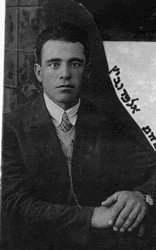 Picture of the author
Picture of the author
In the year 1918 to 1919, the youths in Kurenets embarked upon the organization
of a Zionist movement in Kurenitz. At that point I was still in school,
I vividly remember how the adults came to us and called for a meeting
of all the students in school and made excited fiery speeches. Even
before we truly understood what they were talking about, the phrase
“the land of Israel” kept beating in our heads. Slowly the
sermons became clearer and we could follow the speeches a little better,
our interest increased. Our intrinsic curiosity was unleashed and our
imagination engaged.
During those days, Tzeirey
Zion, an organization of Zionist youths was established in town as well
as an organization by the name of Cherut and Tchia. Every night, boys
and girls from the school would meet and coordinate games and political
discussions. As time passed we started visiting the surrounding towns.
We would meet with the youths of Vileyka, which was nearby, and we even
exchanged letters with the center in Vilna. At the head of the youth
movement there were leaders, and amongst them there were teachers from
the Hebrew school in town, and they would make speeches about Hebrew
literature, the history of Zionism and the history of the Jewish nation.
We would have parties that aimed to collect funds for Keren Keyemt and
Keren HaYesod (founds for Eretz Israel). Regularly we would make the
rounds of all the homes in town, trying to get donations for the miscellaneous
Hebrew national foundations. We would sell pictures of the Zionist leaders,
and once in a while we would put on plays in which we participated as
amateur actors. In time we succeeded in getting most of the youths in
the area to partake in our activities.
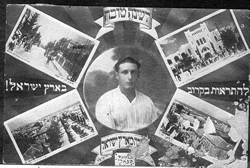 Picture of Ephraim Lieb Kramer
Picture of Ephraim Lieb Kramer
In all such activities, Ephraim
Leib Kramer (son of David, Later changed his last name to Ben David)
was the central figure. He would organize and energize the activities
with his charismatic personality. He had a most splendid penmanship.
Each letter looked like a pearl. He would also write all the correspondence,
and during the meetings, he would many times debate much older people
with courage and introspection and acumen. He was chosen as the head
of the Zionist committee in with his energetic personality, the local
branch was brimming with activities.
In the year 1922, the branch
of Ha’chalutz was established in Kurenets. We communicate with
the center and follow their instructions from the very start. I remember
that year a few leaders from the center of the Ha’chalutz in Warsaw
came to Kurenets. Amongst them were Y. Bankover and A. Dobkin. They
gathered us and told us about our mission for the future. We all acknowledged
the missions that they suggested to us, which would be concluded by
immigration to the land of Israel. AT the very beginning there were
only a few members in Ha’chalutz, but at the end of the year, the
branch in Kurenets became a very respected branch and was renowned in
the entire region of Vilna.
We chose members to head
the organization, and at the top of the organization (the head of the
branch) we elected Ephraim Leib Kramer. Other promotions were given
to other members of the organization, I amongst them. Each evening we
would meet and discuss issues such as how to enlarge the organization,
how to teach and promote better understanding of the Zionist pioneer
movements among the youths. We started organizing the Ha’chalutz
not only in our town but also throughout the whole region. We would
go to all the neighboring towns and we were successful in time and managed
to get other youths that were committed to founding branches in other
shtetls.
Ephraim Leib gave a lot of
time and energy to these activities. Every Saturday, we would meet halfway
between Kurenets and Vileyka with the youths in the area. There we would
spend hours singing and strolling together. During that time we started
organizing HaChsharah ( training to live in an agricultural community
in Israel), founding farming communities in different places in Poland
as educational places/training places to study agriculture. We sent
some members of our branch to such communities. I was among the first
to live there. I went to agricultural community by the name of Trumpeldoria
near Vilna (in Lobodov?). There we lived and worked in an agricultural
community. We learned how to clear and plow fields, plant seed, and
milk cows
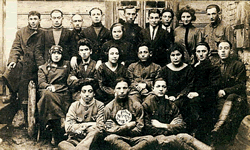 Picture of Hachalutz in Lebodove
Picture of Hachalutz in Lebodove
I spent almost two years
in the agricultural community. Ephraim was not able to go to the ranch
since his father had died and he now became responsible for the support
of his family. Despite his many responsibilities, he spent much of his
time volunteering for the Ha’chalutz movement in Kurenets. In the
year 1925 he immigrated to Israel together with his mother and his siblings,
and after a few months, I joined him in Israel.
I came to Israel together
with a group called Hakovesh. We arrived during the very hot summer
days to Petach Tikva. These were very difficult times. There was much
unemployment, and most of the agricultural work was done at that time
by the Arabs, and owners of orange groves in the area traditionally
gave all the jobs to Arabs who were experienced and worked for modest
compensations. Since we wanted to get those jobs, we had to work very
hard to compete with the Arabs. We had to acclimate ourselves to jobs
that were not familiar to us in Poland, in very hot climate that we
were not used to, working many hours for very small rewards.
Every Saturday we would walk
to Tel Aviv. There was no public transportation yet. We walked through
the sand; there was not one road yet. Not only that, but we couldn’t
even hire a horse and carriage to take us because we couldn’t pay
for the trip. So, like this we walked in the sand, barefoot, with our
clothes tattered, and hungry.
Ephraim, who came with his
family, was able to purchase a home in the community of Trumpeldor,
which is now the main thoroughfare in Tel Aviv, Dizingoff Street. He
worked in the field of music. The house of Ephraim Kramer became like
an island of Kurenets in the midst of Tel Aviv. Every Kurenetser who
arrived in Tel Aviv would come to him, and he would receive us with
extreme warmth. Since we were all new to Israel and everything was so
foreign to us, Eprhaim Leib’s house where everyone was invited
to sleep and to eat was a haven to us. The house was always filled with
guests. It seemed like every day there were new arrivals from Kurenets,
and everyone would gather at Ephraim’s house.
There were times when the
new immigrants were not able to find shelter when they first arrived,
and they would stay with him for many days. I will never forget our
regular visits, every time we would come during Purim to Tel Aviv and
we would feel like a big happy family when we walked together through
the streets of Tel Aviv.
Some weeks after Ephraim
Leib arrived to Israel he got a good job in Tel Aviv and was able to
support himself. Dizingoff, the mayor of Tel Aviv, liked Ephraim very
much, and wanted to give him a very respectable job in his cabinet.
Ephraim refused to accept the appointment, saying that all the “respectable
appointments” he wanted to leave behind him in the Diaspora of
Poland. Here he came to Israel to live the life of a hard-working pioneer.
Amongst the family members who came with him was his aunt Nechama Dina, who was like a mother to all of us. She seemed to have unlimited energy. She always prepared our favorite foods for us. She was a pious woman, and in all her actions was dedicated to the youths from Kurenets.
In 1934, I left the area and transferred to Afula, and my visits with
the rest of the Kurenetsers became limited because the distance was
too great. But still, once in a while I would visit the Kramers. At
some point, Ephraim moved to Ramat Ha’Sharon, where he established
a most impressive agricultural ranch. At that time, Ramat Ha’Sharon
was truly an out of the way place. His house stood alone between Ramat
Ha’Sharon and Hertzlia. His economical situation was very good
and he seemed very happy….
…One day, I opened the
newspaper and I started shaking. I read an announcement for the memorial
of Ephraim Ben David Kramer in the cemetery in Hertzlia. I immediately
went to the funeral and stood in shock by his grave. My heart filled
with pain when I saw his mother Sarah Hinda. You could hardly recognize
her. It seemed like old age overtook her from all her pain. This small
Kurenets Island was overcome by waves of grief…
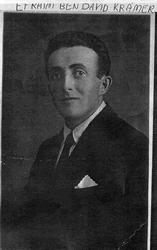 Picture
of Efraim Ben David (kramer) in Eretz Israel.
Picture
of Efraim Ben David (kramer) in Eretz Israel.
The family of Avraham Aharon
as told by his son Reuven,
My father, Avraham Aharon
Alperovich was born in Kurenets, his father was Yehoshua, son of Noach
Zalman. His mother was Rivka. Rivka was related to the Gurevitz family.
My father was one of the first Kurenitzers to make "Aliah"
to Eretz Israel in 1925. In 1927 my father was sent from Eretz Israel
to a Zionist congress in Vilna.
Commonly when unmarried Zionist who had passports that allowed them
to live in Eretz Israel visited Poland they volunteered to factiously
marry local Zionist girls so they could bring them back to Eretz Israel
(Visas were almost impossible to obtain otherwise). A girl from Moldechno
from the Gutkovich family wanted to go to Israel, after they met for
the factious marriage they fall in love and marriage became real .
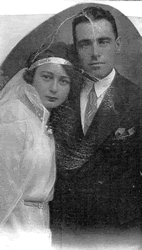 Picture
of Avraham Aharon and his wife
Picture
of Avraham Aharon and his wife
They came to Israel to farm the land. They first settled in Gan Chaim,
a community that had others from Kurenets as members (translator’
note; My mother, Rachel nee Gurevitz, was born there in 1929). Kurenitzers
in America financed the establishment Gan Chaim. The family of my mother
(her mother with six of her half siblings) followed my mother to Israel
a year later. My mothers’ father lived to the age of 105. He had
three wives and with each one he had some children. After his first
wife died he married a widow by the name Mrs. Axelrod. Mrs. Axelrod
had a son from her previous marriage by the name of Max Axelrod who
immigrated to America and became very well off. Max who was never married,
was a Zionist and philanthropist and gave money for many causes. He
was the one who financed the immigration of the third Mrs. Gutkovich
with the six kids. Max sent the family many new gadgets from America,
amongst them was an electric iron. Electric irons were not common at
that time and the Third Mrs. Axelrod never used one before. She misused
it (the cord was in water? ) and died on the spot. The kids were dispersed
amongst family members and boarding schools. She was about 42 years
old when she died. The entire family is still very attached to us. In
the 1930s Max had a strong premonition of the tragedies that the Jews
are about to face in Europe. He went back to Poland in 1938 to beg his
half sister (also sister to my mother) to immigrate to Israel. The sister
who was married with children and well off refused to go and the family
perished in Molodechno three years later. After Max retired he came
to live with us in the large farm he purchased for us in Afula. He diligently
work the farm until he died at age ninety. He had a great influence
on my life. My brother Amos and I followed in the footsteps of my parents
and uncles and we both have farms. My farm is in Nir- Banim
My son Yehoshua (named after my grandfather) runs the big farm while
I have traveled around the world as an adviser to farmers. Yehoshua
has four children. My son Nir has an important job in the high tech
industry in Israel. He is a father of three children.
My daughter works as a researcher in pharmaceuticals for the American
company Pozer in their Israeli branch. She has two sons. A few years
ago I visited Kurenets and Molodechno I was joined by relatives Pesach
Gutkovich. In Kurenitz a local official guided us and showed us a few
memorials that were erected for the Jews of Kurenets. One was for the
more then 1000 Jews who perished in 9-9-1942. Shalom Yoran financed
the memorial. Shalom with his family were refugees in 1939 fleeing the
Nazis who took over their hometown in the western region of Poland in
September of 1939. They arrived in Kurenitz were the lived until 9-9-1942.
His parents perished on that day with the Jewish residents of Kurenets.
Shalom and his brother escaped with other Kurenitzers and joined the
Soviet partisans to fight the Germans.
The Soviet authorities erected
another memorial. It is for the ‘Soviet citizen” who were
killed on Simchat Torah of 1941 (it does not say that all 54 of them
were Jewish). My fathers’ brother; Asher as well as my grandparents;
Yehoshua ben Zalman Noach and my grandmother; Rivka perished on that
day.
I also visited the old Jewish cemetery in Kurenets. The old cemetery
was there for hundreds of years and you could see many names written
in beautiful Hebrew lettering. Many of the graves are fallen and in
disarray. I found many grave stones for Alperovicz family members (most
common last name in Kurenets)
But many of the stones said only first names and first names of fathers
and grandfathers as was more common way of identifying Jews in the area.
After spending hours looking
at the graves I needed to relieve myself and there was no public bathroom
in the area. I went to what I thought was just outside the cemetery,
where there were many wild tall bushes. I cleared the area a little
bit to relieve myself, and when I was standing there I felt something
soft underneath my feet. I looked down clearing more bushes and found
a gravestone with Hebrew lettering and it said the name, Reuven Alperovich,
who died at the young age of 25 from Typhus. I was sure it was my ancestor,
the one I was named after and I made a vow that day that I would organize
a committee that t to clear the cemetery and re-erect the gravestones.
I am looking for the families of the siblings of my father. My father’s
sister went to Argentina in the early 1920s. She might have lived in
the community that the baron Hirsh established. She was married and
had children but she died at a very young age (maybe of typhus) and
we lost touch with the family and I don’t remember their last name.
My father had a brother by the name of Shmuel in Kurenitz who was considered
the black sheep of the family. I heard stories that he married the homely
daughter of a well of hotel owner in the Kurenets area and had children
with her. After a time he took a local non-Jewish woman as his lover.
When the Soviets took control of the area in 1939 he worked for them
running a cooperative. As the Germans attacked the Soviet Union in September
of 1941 my uncle knew that he would be killed for cooperating with the
communists but was naïve and believed that they would not harm
his wife and children. He escaped with his lover and went all the way
to Kazchstan. He stayed there until the war ended. His wife and children
escaped to the forest on the day of the action in Kurenitz. They were
found in the forest by the Germans and were killed.